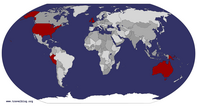Byebye Brizzy My last full day in Brisbane I went to Lone Pine Koala Sanctuary. This is the oldest and largest koala refuge in the world. It was basically like a zoo, but only for native Australian wildlife. There were loads of koalas (as one would expect). I got to pet one and get my picture taken. Among the other wildlife were: dingoes, Tasmanian devils, wombats, many snakes, freshwater crocodiles, emus, kookaburras, platypusses (platypi?), and of course, kangaroos. The neatest part was a large park area with emus and kangaroos just milling about. Any zoo attendee could go in and just go up to the kangaroos, take pictures, feed them, lay on them, pet them; really anything you wanted to do. I took a few self portraits with some of the more sociable animals. My transportation
... read more




